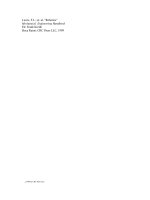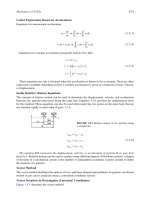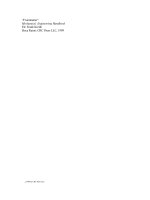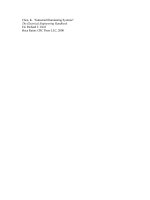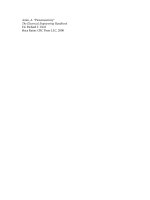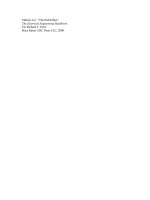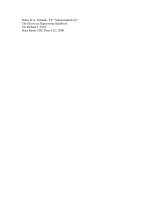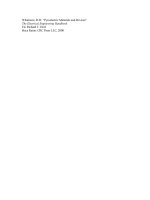Structural engineering handbook
Bạn đang xem bản rút gọn của tài liệu. Xem và tải ngay bản đầy đủ của tài liệu tại đây (26.81 MB, 1,650 trang )
“Frontmatter”
Structural Engineering Handbook
Ed. Chen Wai-Fah
Boca Raton: CRC Press LLC, 1999
Structural Engineering Contents
1 Basic Theory of Plates and Elastic Stability Eiki Yamaguchi
2 Structural Analysis J.Y. Richard Liew, N.E. Shanmugam, and C.H. Yu
3 Structural Steel Design
1
E. M. Lui
4 Structural Concrete Design
2
Amy Grider and Julio A. Ramirez and Young Mook Yun
5 Earthquake Engineering Charles Scawthorn
6 Composite Construction Edoardo Cosenza and Riccardo Zandonini
7 Cold-Formed Steel Structures Wei-Wen Yu
8 Aluminum Structures Maurice L. Sharp
9 Timber Structures Kenneth J. Fridley
10 Bridge Structures Shouji Toma, Lian Duan, and Wai-Fah Chen
11 Shell Structures Clarence D. Miller
12 Multistory Frame Structures J. Y. Richard Liew and T. B alendra and W. F. Chen
13 Space Frame Structures Tien T. Lan
14 Cooling Tower Structures Phillip L. Gould and Wilfried B. Krätzig
15TransmissionStructuresShu-jinFang,SubirRoy,andJacobKramer
c
1999byCRCPressLLC
16 Performance-Based Seismic Design Criteria For Bridges LianDuanandMarkReno
15B Tunnel Structures Birger Schmidt, Christian Ingerslev, Brian Brenner, and J N. Wang
17 Effective Length Factors of Compression Members Lian Duan and W.F. Chen
18 Stub Girder Floor Systems Reidar Bjorhovde
19 Plate and Box Girders MohamedElgaaly
20 Steel Bridge Construction Jackson Durkee
21 Basic Principles of Shock Loading O.W. Blodgett and D.K. Miller
22 Welded Connections O.W. Blodgett and D. K. Miller
23 Composite Connections Roberto Leon
24 Fatigue and Fracture Robert J. Dexter and John W. Fisher
25 Underground Pipe J. M. Doyle and S.J. Fang
26 Structural Reliability
3
D. V. Rosowsky
27 Passive Energy D issipation and Active Control T.T. Soong and G.F. Dargush
28 An Innnovative Design For Steel Frame Using Advanced Analysis
4
Seung-Eock Kim and
W. F. Chen
29 Welded Tubular Connections—CHS Trusses Peter W. Marshall
c
1999 by CRC Press LLC
30 Earthquake Damage to Structures Mark Yashinsky
Yamaguchi, E. “Basic Theory of Plates and Elastic Stability”
Structural Engineering Handbook
Ed. Chen Wai-Fah
Boca Raton: CRC Press LLC, 1999
BasicTheoryofPlatesandElastic
Stability
EikiYamaguchi
DepartmentofCivilEngineering,
KyushuInstituteofTechnology,
Kitakyusha,Japan
1.1 Introduction
1.2 Plates
BasicAssumptions
•
GoverningEquations
•
BoundaryCon-
ditions
•
CircularPlate
•
ExamplesofBendingProblems
1.3 Stability
BasicConcepts
•
StructuralInstability
•
Columns
•
Thin-
WalledMembers
•
Plates
1.4 DefiningTerms
References
FurtherReading
1.1 Introduction
Thischapterisconcernedwithbasicassumptionsandequationsofplatesandbasicconceptsofelastic
stability.Herein,weshallillustratetheconceptsandtheapplicationsoftheseequationsbymeansof
relativelysimpleexamples;morecomplexapplicationswillbetakenupinthefollowingchapters.
1.2 Plates
1.2.1 BasicAssumptions
WeconsideracontinuumshowninFigure1.1.Afeatureofthebodyisthatonedimensionismuch
smallerthantheothertwodimensions:
t<<L
x
,L
y
(1.1)
wheret,L
x
,andL
y
arerepresentativedimensionsinthreedirections(Figure1.1).Ifthecontinuum
hasthisgeometricalcharacteristicofEquation1.1andisflatbeforeloading,itiscalledaplate.Note
thatashellpossessesasimilargeometricalcharacteristicbutiscurvedevenbeforeloading.
ThecharacteristicofEquation1.1lendsitselftothefollowingassumptionsregardingsomestress
andstraincomponents:
σ
z
= 0 (1.2)
ε
z
= ε
xz
=ε
yz
=0 (1.3)
WecanderivethefollowingdisplacementfieldfromEquation1.3:
c
1999byCRCPressLLC
FIGURE 1.1: Plate.
u(x,y,z) = u
0
(x, y) − z
∂w
0
∂x
ν(x,y, z) = ν
0
(x, y) − z
∂w
0
∂y
(1.4)
w(x,y,z) = w
0
(x, y)
whereu, ν, andw aredisplacementcomponentsinthedirections of x-, y-, and z-axes,respectively.
AscanberealizedinEquation1.4,u
0
andν
0
aredisplacementcomponentsassociatedwith the plane
ofz = 0. Physically,Equation1.4impliesthatthelinearfilamentsoftheplateinitiallyperpendicular
to the middle surface remain straight and perpendicular to the deformed middle surface. This is
knownastheKirchhoffhypothesis. AlthoughwehavederivedEquation1.4fromEquation1.3inthe
above,onecanarriveatEquation1.4startingwiththeKirchhoffhypothesis: theKirchhoffhypothesis
is equivalent to the assumptions of Equation 1.3.
1.2.2 Governing Equations
Strain-Displacement Relationships
Using the strain-displacement relationships in the continuum mechanics, we can obtain the
following strain field associated with Equation 1.4:
ε
x
=
∂u
0
∂x
− z
∂
2
w
0
∂x
2
ε
y
=
∂ν
0
∂y
− z
∂
2
w
0
∂y
2
(1.5)
ε
xy
=
1
2
∂u
0
∂y
+
∂ν
0
∂x
− z
∂
2
w
0
∂x∂y
This constitutes the strain-displacement relationships for the plate theory.
Equilibrium Equations
In the plate theory, equilibrium conditions are considered in terms of resultant forces and
moments. This is derived by integrating the equilibrium equations over the thickness of a plate.
Because of Equation 1.2, we obtain the equilibrium equations as follows:
c
1999 by CRC Press LLC
∂N
x
∂x
+
∂N
xy
∂y
+ q
x
= 0 (1.6a)
∂N
xy
∂x
+
∂N
y
∂y
+ q
y
= 0 (1.6b)
∂V
x
∂x
+
∂V
y
∂y
+ q
z
= 0 (1.6c)
where N
x
,N
y
, and N
xy
are in-plane stress resultants; V
x
and V
y
are shearing forces; and q
x
,q
y
,
and q
z
are distributed loads per unit area. The terms associated with τ
xz
and τ
yz
vanish, since in the
plate problems the top and the bottom surfaces of a plate are subjected to only vertical loads.
We must also consider the moment equilibrium of an infinitely small region of the plate, which
leads to
∂M
x
∂x
+
∂M
xy
∂y
− V
x
= 0
∂M
xy
∂x
+
∂M
y
∂y
− V
y
= 0 (1.7)
where M
x
and M
y
are bending moments and M
xy
is a twisting moment.
The resultant forces andthe moments are defined mathematically as
N
x
=
z
σ
x
dz (1.8a)
N
y
=
z
σ
y
dz (1.8b)
N
xy
= N
yx
=
z
τ
xy
dz (1.8c)
V
x
=
z
τ
xz
dz (1.8d)
V
y
=
z
τ
yz
dz (1.8e)
M
x
=
z
σ
x
zdz (1.8f)
M
y
=
z
σ
y
zdz (1.8g)
M
xy
= M
yx
=
z
τ
xy
zdz (1.8h)
The resultant forces andthe moments are illustrated in Figure 1.2.
Constitutive Equations
Since the thickness of a plate is small in comparison with the other dimensions, it is usually
acceptedthattheconstitutiverelationsforastateofplanestressareapplicable. Hence,thestress-strain
relationships foran isotropic plate are given by
σ
x
σ
y
τ
xy
=
E
1 − ν
2
1 ν 0
ν 10
00(1 − ν)/2
ε
x
ε
y
γ
xy
(1.9)
c
1999 by CRC Press LLC
FIGURE 1.2: Resultant forces and moments.
whereE andν areYoung’smodulusandPoisson’sratio,respectively. UsingEquations1.5,1.8,and1.9,
theconstitutiverelationshipsforanisotropicplateintermsofstressresultantsanddisplacementsare
described by
N
x
=
Et
1 − ν
2
∂u
0
∂x
+ ν
∂ν
0
∂y
(1.10a)
N
y
=
Et
1 − ν
2
∂ν
0
∂y
+ ν
∂u
0
∂x
(1.10b)
N
xy
= N
yx
Et
2(1 + ν)
∂ν
0
∂x
+
∂u
0
∂y
(1.10c)
M
x
=−D
∂
2
w
0
∂x
2
+ ν
∂
2
w
0
∂y
2
(1.10d)
M
y
=−D
∂
2
w
0
∂y
2
+ ν
∂
2
w
0
∂x
2
(1.10e)
M
xy
= M
yx
=−(1 − ν)D
∂
2
w
0
∂x∂y
(1.10f)
where t is the thickness of a plate and D is the flexural rigidit y defined by
D =
Et
3
12(1 − ν
2
)
(1.11)
InthederivationofEquation1.10,wehaveassumedthattheplatethicknesst is constantandthatthe
initial middle surface lies in the plane of Z = 0. Through Equation 1.7, we can relate the shearing
forces to the displacement.
Equations 1.6, 1.7, and 1.10 constitute the framework of a plate problem: 11 equations for 11
unknowns, i.e., N
x
,N
y
,N
xy
,M
x
,M
y
,M
xy
,V
x
,V
y
,u
0
,ν
0
, and w
0
. In the subsequent sections,
we shall drop thesubscript 0 thathas been associated with the displacements for the sake of brevity.
In-Plane and Out-Of-Plane Problems
As may be realized in the equations derived in the previous section, the problem can be de-
composed into two sets of problems which are uncoupled with each other.
1. In-plane problems
The problem may be also called a stretching problem of a plate andis governed by
c
1999 by CRC Press LLC
∂N
x
∂x
+
∂N
xy
∂y
+q
x
=0
∂N
xy
∂x
+
∂N
y
∂y
+q
y
=0 (1.6a,b)
N
x
=
Et
1−ν
2
∂u
∂x
+ν
∂ν
∂y
N
y
=
Et
1−ν
2
∂ν
∂y
+ν
∂u
∂x
N
xy
= N
yx
=
Et
2(1+ν)
∂ν
∂x
+
∂u
∂y
(1.10a∼c)
Herewehavefiveequationsforfiveunknowns.Thisproblemcanbeviewedandtreated
inthesamewayasforaplane-stressprobleminthetheoryoftwo-dimensionalelasticity.
2.Out-of-planeproblems
Thisproblemisregardedasabendingproblemandisgovernedby
∂V
x
∂x
+
∂V
y
∂y
+q
z
=0 (1.6c)
∂M
x
∂x
+
∂M
xy
∂y
−V
x
=0
∂M
xy
∂x
+
∂M
y
∂y
−V
y
=0 (1.7)
M
x
=−D
∂
2
w
∂x
2
+
∂
2
w
∂y
2
M
y
=−D
∂
2
w
∂y
2
+
∂
2
w
∂x
2
M
xy
= M
yx
=−(1−ν)D
∂
2
w
∂x∂y
(1.10d∼f)
Herearesixequationsforsixunknowns.
EliminatingV
x
andV
y
fromEquations1.6cand1.7,weobtain
∂
2
M
x
∂x
2
+2
∂
2
M
xy
∂x∂y
+
∂
2
M
y
∂y
2
+q
z
=0 (1.12)
SubstitutingEquations1.10d∼fintotheabove,weobtainthegoverningequationintermsofdis-
placementas
D
∂
4
w
∂x
4
+2
∂
4
w
∂x
2
∂y
2
+
∂
4
w
∂y
4
=q
z
(1.13)
c
1999byCRCPressLLC
or
∇
4
w =
q
z
D
(1.14)
where the operator is defined as
∇
4
=∇
2
∇
2
∇
2
=
∂
2
∂x
2
+
∂
2
∂y
2
(1.15)
1.2.3 Boundary Conditions
Since the in-plane problem of a plate can be treated as a plane-stress problem in the theory of
two-dimensional elasticity, the present section is focused solely on a bending problem.
Introducing the n-s-z coordinate system alongside boundaries as shown in Figure 1.3, we define
the moments and the shearing force as
M
n
=
z
σ
n
zdz
M
ns
= M
sn
=
z
τ
ns
zdz (1.16)
V
n
=
z
τ
nz
dz
In the plate theor y, instead of considering these three quantities, we combine the twisting moment
and theshearing force by replacing the action of the twisting momentM
ns
with that of the shearing
force, as can be seen in Figure 1.4. We then define the joint ver tical as
S
n
= V
n
+
∂M
ns
∂s
(1.17)
The boundary conditions are therefore given in general by
w =
w or S
n
= S
n
(1.18)
−
∂w
∂n
=
λ
n
or M
n
= M
n
(1.19)
where the quantitieswith a barare prescribed valuesand are illustrated in Figure 1.5. These two sets
of boundary conditions ensure the unique solution of a bending problem of a plate.
FIGURE 1.3: n-s-z coordinate system.
The boundary conditions for some practical cases are as follows:
c
1999 by CRC Press LLC
FIGURE 1.4: Shearing force due to twisting moment.
FIGURE 1.5: Prescribed quantities on the boundary.
1. Simply supported edge
w = 0,M
n
= M
n
(1.20)
2. Built-in edge
w = 0,
∂w
∂n
= 0
(1.21)
c
1999 by CRC Press LLC
3. Free edge
M
n
= M
n
,S
n
= S
n
(1.22)
4. Free corner (intersection of free edges)
At the free corner, the twisting moments cause vertical action, as can be realized is Fig-
ure 1.6. Therefore, the following condition must be satisfied:
− 2M
xy
= P (1.23)
where P is theexternal concentrated load acting in theZ direction at the corner.
FIGURE 1.6: Vertical action atthe corner due to twisting moment.
c
1999 by CRC Press LLC
1.2.4 Circular Plate
Governing equations in the cylindrical coordinates are more convenient when circular plates are
dealt with. Through the coordinate transformation, we can easily derive the Laplacian operator in
the cylindrical coordinates and the equation that governs the behavior of the bending of a circular
plate:
∂
2
∂r
2
+
1
r
∂
∂r
+
1
r
2
∂
2
∂θ
2
∂
2
∂r
2
+
1
r
∂
∂r
+
1
r
2
∂
2
∂θ
2
w =
q
z
D
(1.24)
The expressions of the resultants are given by
M
r
=−D
(1 − ν)
∂
2
w
∂r
2
+ ν∇
2
w
M
θ
=−D
∇
2
w + (1 − ν)
∂
2
w
∂r
2
M
rθ
= M
θr
=−D(1 − ν)
∂
∂r
1
r
∂w
∂θ
(1.25)
S
r
= V
r
+
1
r
∂M
rθ
∂θ
S
θ
= V
θ
+
∂M
rθ
∂r
When the problem is axisymmetric, the problem can be simplified because all the variables are
independent of θ. The governing equation for the bending behavior and the moment-deflection
relationships thenbecome
1
r
d
dr
r
d
dr
1
r
d
dr
r
dw
dr
=
q
z
D
(1.26)
M
r
= D
d
2
w
dr
2
+
ν
r
dw
dr
M
θ
= D
1
r
dw
dr
+ ν
d
2
w
dr
2
(1.27)
M
rθ
= M
θr
= 0
Since the twisting moment does not exist, no particular care is needed about vertical actions.
1.2.5 Examples of Bending Problems
Simply Supported Rectangular Plate Subjected to Uniform Load
A plate shown in Figure 1.7is considered here. The governing equation is given by
∂
4
w
∂x
4
+ 2
∂
4
w
∂x
2
∂y
2
+
∂
4
w
∂y
4
=
q
0
D
(1.28)
in which q
0
represents the intensity of the load. The boundary conditions for the plate are
w = 0,M
x
= 0 along x = 0,a
w = 0,M
y
= 0 along y = 0,b (1.29)
c
1999 by CRC Press LLC
UsingEquation1.10,wecanrewritetheboundaryconditionsintermsofdisplacement. Furthermore,
since w = 0 along the edges, we observe
∂
2
w
∂x
2
= 0 and
∂
2
w
∂y
2
= 0 for the edges parallel to the x and y
axes, respectively, so thatwe may describe the boundary conditions as
w = 0,
∂
2
w
∂x
2
= 0 along x = 0,a
w = 0,
∂
2
w
∂y
2
= 0 along y = 0,b (1.30)
FIGURE 1.7: Simply supported rectangular plate subjected to uniform load.
We represent the deflection in the double trigonometric series as
w =
∞
m=1
∞
n=1
A
mn
sin
mπx
a
sin
nπy
b
(1.31)
It is noted that this function satisfies all the boundary conditions of Equation 1.30. Similarly, we
express the load intensity as
q
0
=
∞
m=1
∞
n=1
B
mn
sin
mπx
a
sin
nπy
b
(1.32)
where
B
mn
=
16q
0
π
2
mn
(1.33)
Substituting Equations 1.31 and 1.32 into 1.28, we can obtain the expression of A
mn
to yield
w =
16q
0
π
6
D
∞
m=1
∞
n=1
1
mn
m
2
a
2
+
n
2
b
2
2
sin
mπx
a
sin
nπy
b
(1.34)
c
1999 by CRC Press LLC
We can readily obtain the expressions for bending and twisting moments by differentiation.
Axisymmetric Circular Plate with Built-In Edge Subjected to Uniform Load
The governing equationof the plate shown in Figure 1.8 is
1
r
d
dr
r
d
dr
1
r
d
dr
r
dw
dr
=
q
0
D
(1.35)
where q
0
is the intensity of the load. The boundary conditions for the plate are given by
w =
dw
dr
= 0 at r = a
(1.36)
FIGURE 1.8: Circular plate with built-inedge subjected to uniform load.
We can solve Equation 1.35 without much difficulty to yield the following general solution:
w =
q
0
r
4
64D
+ A
1
r
2
ln r + A
2
ln r + A
3
r
2
+ A
4
(1.37)
We have four constants ofintegration inthe above, whilethere are only two boundary conditions of
Equation 1.36. Claiming that nosingularities shouldoccurin deflection andmoments, however, we
can eliminate A
1
and A
2
, so that we determine the solution uniquely as
w =
q
0
a
4
64D
r
2
a
2
− 1
2
(1.38)
Using Equation 1.27, we can readily compute the bending moments.
c
1999 by CRC Press LLC
1.3 Stability
1.3.1 Basic Concepts
States of Equilibrium
To illustrate various forms of equilibrium, we consider three cases of equilibrium of the ball
shown inFigure1.9. We caneasily see that if itis displaced slightly, the ball on theconcavespherical
surface will return to its original position upon the removal of the disturbance. On the other hand,
theballontheconvexsphericalsurfacewill continuetomovefartherawayfromtheoriginal position
ifdisplacedslightly. Abodythatbehavesintheformerwayissaidtobeinastateofstableequilibrium,
while the latter is called unstable equilibrium. The ball on the horizontal plane shows yet another
behavior: it remains atthe positionto which thesmall disturbance hastakenit. This is called a state
of neutral equilibrium.
FIGURE 1.9: Three states of equilibrium.
For further illustration, we consider a system of a rigid bar and a linear spring. The vertical load
P is applied at the top of the bar as depicted in Figure 1.10. When small disturbance θ is given, we
can compute the moment about Point B M
B
, yielding
M
B
= PLsin θ − (kL sin θ)(L cosθ)
= L sinθ(P − kLcosθ)
(1.39)
Using the fact that θ is infinitesimal, we can simplify Equation 1.39 as
M
B
θ
= L(P − kL)
(1.40)
We can claim that the system is stable when M
B
acts in the opposite direction of the disturbance θ;
thatitisunstablewhen M
B
andθ possess thesamesign;andthatitisin astateofneutral equilibrium
when M
B
vanishes. This classification obviously shares the same physical definition as that used in
the first example (Figure 1.9). Mathematically, the classification is expressed as
(P − kL)
< 0 : stable
= 0 : neutral
> 0 : unstable
(1.41)
Equation 1.41implies that as P increases, thestate of the system changes from stableequilibrium to
unstable equilibrium. The critical load is kL, at which multiple equilibrium positions, i.e., θ = 0
and θ = 0, are possible. Thus, the critical load serves also as a bifurcation point of the equilibrium
path. The load at such a bifurcation is called the buckling load.
c
1999 by CRC Press LLC
FIGURE 1.10: Rigid bar AB with a spring.
For the present system, the buckling load of kL is stability limit as well as neutral equilibrium.
In general, the buckling load corresponds to a state of neut ral equilibrium, but not necessarily to
stability limit. Nevertheless, the buckling load is often associated with the characteristic change of
structural behavior, and therefore can be regarded as the limit state of serviceability.
Linear Buckling Analysis
Wecancomputeabucklingloadbyconsideringanequilibriumconditionforaslightlydeformed
state. For the system of Figure 1.10, the moment equilibrium yields
PLsin θ − (kL sin θ)(L cosθ) = 0
(1.42)
Since θ is infinitesimal, we obtain
Lθ(P − kL) = 0
(1.43)
It is obvious that this equation is satisfied for any value of P if θ is zero: θ = 0 is called the
trivial solution. We are seeking the buckling load, at which the equilibrium condition is satisfiedfor
θ = 0. The trivial solution is apparently of no importance and from Equation 1.43 we can obtain
the following buckling loadP
C
:
P
C
= kL (1.44)
A rigorous buckling analysis is quite involved, where we need to solve nonlinear equations even
when elastic problems are dealt with. Consequently, the linear buckling analysis is frequently em-
ployed. The analysis can be justified, if defor mation is negligible and structural behavior is linear
beforethebucklingloadisreached. ThewaywehaveobtainedEquation1.44intheaboveisatypical
application of the linear buckling analysis.
In mathematical terms, Equation 1.43 is called a characteristic equation and Equation 1.44 an
eigenvalue. The linear buckling analysis is in fact regarded asan eigenvalue problem.
1.3.2 Structural Instability
Three classes of instability phenomenon are observed in structures: bifurcation, snap-through, and
softening.
We have discussed a simple example of bifurcation in the previous section. Figure 1.11a depicts
a schematic load-displacement relationship associated with the bifurcation: Point A is where the
c
1999 by CRC Press LLC
bifurcation takes place. In reality, due to imperfection such as the initial crookedness of a member
and the eccentricity of loading, we can rarely observe the bifurcation. Instead, an actual structural
behavior would be more like the one indicated in Figure 1.11a. However, the bifurcation load is still
an important measure regarding structural stability and most instabilities of a column and a plate
are indeed of this class. In many cases we can evaluate the bifurcation point by the linear buckling
analysis.
In some structures, we observe that displacement increases abruptly at a certain load level. This
can take place atPointA in Figure 1.11b; displacement increases from U
A
to U
B
at P
A
, as illustrated
byabrokenarrow. Thephenomenoniscalled snap-through. TheequilibriumpathofFigure1.11bis
typicalofshell-likestructures,includingashallowarch,andistraceableonlybythefinitedisplacement
analysis.
The other instability phenomenon is the softening: as Figure 1.11c illustrates, there exists a peak
load-carrying capacity, beyond which the structural strength deteriorates. We often observe this
phenomenon when yielding takes place. To compute the associated equilibrium path, we need to
resort to nonlinear structural analysis.
Since nonlinear analysis is complicated and costly, the information on stability limit and ultimate
strength is deduced in practice from the bifurcation load, utilizing the linear buckling analysis. We
shall therefore discuss the buckling loads (bifurcation points) of some structures inwhat follows.
1.3.3 Columns
Simply Supported Column
As a first example, we evaluate the buckling load of a simply supported column shown in
Figure1.12a. Tothisend,themomentequilibriuminaslightlydeformedconfigurationisconsidered.
Following the notation in Figure 1.12b, we can readily obtain
w
+ k
2
w = 0 (1.45)
where
k
2
=
P
EI
(1.46)
EI is the bending rigidity of the column. The general solution of Equation 1.45 is
w = A
1
sin kx + A
2
cos kx (1.47)
The arbitrary constants A
1
and A
2
are to be determined by the following boundary conditions:
w = 0 atx = 0
(1.48a)
w = 0 atx = L (1.48b)
Equation 1.48agivesA
2
= 0 and from Equation 1.48bwereach
A
1
sin kL = 0 (1.49)
A
1
= 0 isasolutionofthecharacteristicequationabove,butthisisthetrivialsolutioncorresponding
to aperfectly straight column and is of no interest. Then we obtain the following buckling loads:
P
C
=
n
2
π
2
EI
L
2
(1.50)
c
1999 by CRC Press LLC
FIGURE 1.11: Unstable structural behaviors.
c
1999 by CRC Press LLC
FIGURE 1.12: Simply-supported column.
Although n is any integer, our interest is inthe lowest buckling load w ith n = 1 since it is the critical
load from the practical point of view. The buckling load, thus, obtained is
P
C
=
π
2
EI
L
2
(1.51)
whichisoftenreferredtoastheEulerload. FromA
2
= 0 andEquation1.51, Equation 1.47indicates
the following shape of the deformation:
w = A
1
sin
πx
L
(1.52)
This equation showsthe buckled shapeonly, sinceA
1
representstheundetermined amplitude of the
deflection and can have any value. The deflection curve is illustrated in Figure 1.12c.
The behavior of the simply supported column is summarized as follows: up to the Euler load the
column remains straight; at the Euler load the state of the column becomes the neutral equilibrium
and it can remain straight or itstarts to bendin the mode expressed by Equation 1.52.
c
1999 by CRC Press LLC
Cantilever Column
Forthecantilevercolumn of Figure 1.13a, by considering the equilibriumconditionofthefree
body shown in Figure 1.13b, we can derive the following governing equation:
w
+ k
2
w = k
2
δ (1.53)
where δ is the deflection at the free tip. The boundary conditions are
w = 0 atx = 0
w
= 0 atx = 0 (1.54)
w = δ at x = L
FIGURE 1.13: Cantilever column.
From these equations we can obtain the characteristic equation as
δ cos kL = 0
(1.55)
c
1999 by CRC Press LLC
which yields the following buckling load and deflection shape:
P
C
=
π
2
EI
4L
2
(1.56)
w = δ
1 − cos
πx
2L
(1.57)
The buckling mode is illustrated in Figure 1.13c. It is noted that the boundary conditions make
muchdifferenceinthebucklingload: thepresentbucklingloadis just a quarter ofthatforthesimply
supported column.
Higher-Order Differential Equation
We have thus far analyzed the two columns. In each problem, a second-order differential
equationwasderivedandsolved. Thisgoverningequationisproblem-dependentandvalid onlyfora
particular problem. Amoreconsistentapproachispossiblebymakinguseofthegoverningequation
for a beam-column with no laterally distributed load:
EIw
IV
+ Pw
= q (1.58)
Note that in this equation P is positive when compressive. This equation is applicable to any set of
boundary conditions. The general solution of Equation 1.58 is given by
w = A
1
sin kx + A
2
cos kx + A
3
x + A
4
(1.59)
where A
1
∼ A
4
are arbitrary constants and determined from boundary conditions.
We shall again solve thetwo column problems, usingEquation 1.58.
1. Simply supported column (Figure 1.12a)
Becauseofnodeflectionandnoexternalmomentateachendofthecolumn,theboundary
conditions are described as
w = 0,w
= 0 at x = 0
w = 0,w
= 0 at x = L (1.60)
From the conditions at x = 0, we can determine
A
2
= A
4
= 0
(1.61)
Using this result and the conditions at x = L, we obtain
sin kL L
−k
2
sin kL 0
A
1
A
3
=
0
0
(1.62)
For the nont rivial solution to exist, the determinant of the coefficient matrix in Equa-
tion 1.62 must vanish, leading to the following characteristic equation:
k
2
L sinkL = 0 (1.63)
from which we arrive at the same critical load as in Equation 1.51. By obtaining thecor-
responding eigenvector of Equation 1.62, we cangetthe buckled shapeof Equation 1.52.
c
1999 by CRC Press LLC
2. Cantilever column (Figure 1.13a)
In this column, we observe no deflection and no slope at the fixed end; no external
moment and noexternalshear force at thefreeend. Therefore, theboundary conditions
are
w = 0,w
= 0 at x = 0
w
= 0,w
+ k
2
w
= 0 at x = L
(1.64)
Note that since we are dealing with a slightly deformed column in the linear buckling
analysis,theaxialforcehasatransversecomponent,whichiswhyP comesintheboundary
condition at x = L.
The latter condition at x = L eliminates A
3
. Withthis and thesecond condition at x = 0, we can
claim A
1
= 0. The remaining two conditions thenlead to
11
k
2
cos kL 0
A
2
A
4
=
0
0
(1.65)
The smallest eigenvalueand the corresponding eigenvector of Equation 1.65 coincidewith thebuck-
ling load and the buckling mode that we have obtained previously in Section 1.3.3.
Effective Length
We have obtained the buckling loads for the simply supported and the cantilever columns.
By either the second- or the fourth-order differential equation approach, we can compute buckling
loads for a fixed-hinged column (Figure 1.14a) and a fixed-fixed column (Figure 1.14b) without
much difficulty:
P
C
=
π
2
EI
(
0.7L
)
2
for a fixed - hinged column
P
C
=
π
2
EI
(
0.5L
)
2
for a fixed - hinged column (1.66)
For all the four columns considered thus far, and in fact for the columns with any other sets of
boundary conditions, we can express the buckling load inthe form of
P
C
=
π
2
EI
(
KL
)
2
(1.67)
whereKL is called the effective length andrepresents presumably thelength ofthe equivalent Euler
column (theequivalent simply supported column).
For desig n purposes, Equation 1.67 is often transformed into
σ
C
=
π
2
E
(
KL/r
)
2
(1.68)
wherer istheradiusofgyration defined intermsofcross-sectionalareaA andthemomentofinertia
I by
r =
I
A
(1.69)
For an ideal elastic column, we can draw the curve of the critical stress σ
C
vs. the slenderness ratio
KL/r, as shown in Figure 1.15a.
c
1999 by CRC Press LLC
FIGURE 1.14: (a) Fixed-hinged column; (b) fixed-fixed column.
Fora column of perfectlyplastic material, stress never exceeds theyield stress σ
Y
. For thisclass of
column, we often employ a normalized form of Equation 1.68 as
σ
C
σ
Y
=
1
λ
2
(1.70)
where
λ =
1
π
KL
r
σ
Y
E
(1.71)
ThisequationisplottedinFigure1.15b. Forthiscolumn,withλ<1.0, itcollapsesplastically; elastic
buckling takes place for λ>1.0.
Imperfect Columns
In the derivation of thebuckling loads,we have dealt with the idealized columns; themember
is perfectly straight and the loading is concentric at every cross-section. These idealizations help
simplify the problem, but perfect members do not exist in the real world: minor crookedness of
shape and small eccentricities of loading are always present. To this end, we shall investigate the
behavior of an initially bentcolumn in this section.
We consider a simply supported column shown in Figure 1.16. The column is initially bent and
the initial crookedness w
i
is assumed to be in the form of
w
i
= a sin
πx
L
(1.72)
where a is a small value, representing the magnitude of the initial deflection at the midpoint. If we
describe the additional deformation due to bending as w and consider the moment equilibrium in
c
1999 by CRC Press LLC
FIGURE1.15: (a)Relationshipbetweencriticalstressandslendernessratio;(b)normalizedrelation-
ship.
FIGURE 1.16: Initially bent column.
this configuration, we obtain
w
+ k
2
w =−k
2
a sin
πx
L
(1.73)
where k
2
is defined in Equation 1.46. The general solution of this differential equation is given by
w = A sin
πx
L
+ B cos
πx
L
+
P/P
E
1 − P/P
E
a sin
πx
L
(1.74)
c
1999 by CRC Press LLC

